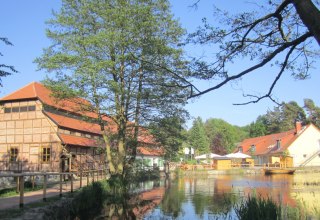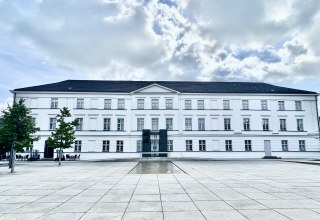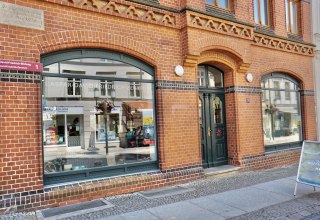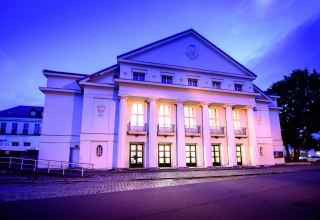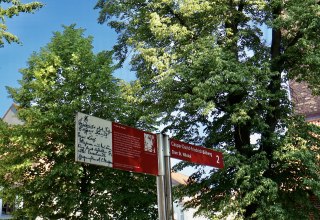The monastery ruins and park are a popular excursion destination for Greifswald residents and their guests. The monastery ruins are also the starting and finishing point of the themed cycle path "Route of North German Romanticism", which traces the stations and lives of the North German Romantics of Western Pomerania.
Caspar David Friedrich (1774-1840) made the ruins of the medieval Cistercian monastery of Eldena widely known with his paintings and drawings. The remains of the once important monastery are embedded in a park with old trees, including 180-year-old oaks, which illustrate Friedrich's ideas and characterize the romantic atmosphere of the grounds. The main accent of the ruins is the imposing west façade of the former monastery church with its high ogival window opening.
The Hilda (Eldena) monastery was founded in 1199 after Cistercian monks were forced to abandon their monastery in Dargun as a result of armed conflict. The new monastery was built to the east of the future town of Greifswald, at the mouth of the River Ryck into the Danish Wiek. In 1248, the "oppidum Gripheswald" was first mentioned in a document among the monastery's possessions and in 1250, today's Greifswald was granted town charter. The monastery ruins are located in the Eldena district, in the immediate vicinity of the fishing village of Wieck and the Greifswald Bodden.
In the Middle Ages, Eldena was the most important monastery in the region, the economic and spiritual center of the area and reached its heyday around 1400. From the early 13th century to the beginning of the 15th century, it was structurally designed to reflect its importance. The monastery existed until the Reformation in the region in 1533 and subsequently fell into disrepair.
In 1634, the University of Greifswald received the Office of Eldena from the last Duke of Pomerania, Bogislaw XIV, and with it the monastery grounds and associated land. After plundering by imperial and Swedish troops during the Thirty Years' War, the remains of the medieval monastery complex fell into disrepair. From the second half of the 17th century, they were even used as a quarry for fortifications and university buildings in Greifswald.
The rescue of the complex is largely due to the intervention of the Prussian Crown Prince Friedrich Wilhelm (1795-1861, later King Friedrich Wilhelm IV), who was enthusiastic about romantic ideas. In 1827, he found the ruins in a dilapidated state. As a result, the first clearing and restoration work was carried out between 1828 and 1832 and a park was laid out to make the site accessible. Oak trees were planted in place of the missing nave pillars. The merging of the eternally recurring nature with the venerable architectural evidence of an irretrievably past time carries a profound symbolism that also captivates today's visitors at all times of the year and day.
Caspar David Friedrich, born in Greifswald in 1774, made the Eldena monastery ruins world-famous. He is now regarded as the most important painter and draughtsman of the early German Romantic period and used sketches of the monastery ruins as models for his paintings "Winter", "Monastery Ruins in the Giant Mountains" and "Abbey in Eichwald", among others. Some of his works are on display in the Pomeranian State Museum. In the Caspar David Friedrich Center in Greifswald's city centre, you can experience the life and work of the painter in an impressive way.
The post-Reformation history of the estate includes the expansion of the Amtsgut and the founding of an agricultural academy in 1835, which existed until 1876. The remaining monastery buildings were also used for agricultural purposes.
The monastery ruins have been owned by the University and Hanseatic City of Greifswald since 1937. Nowadays, the monastery ruins and the surrounding park are a popular local recreation area, a landmark of the town and a backdrop for filming and various events. In summer, there are regular theater performances, the Eldena Monastery Market (since 2014), the Eldena Jazz Evenings (since 1981) and other concerts and events. The monastery ruins are a stop on the Caspar David Friedrich Picture Trail and the European Route of Brick Gothic.
Parking & directions: https://www.greifswald.de/de/freizeit-kultur/veranstaltungen/maerkte/klostermarkt/anfahrt-klosterruine-eldena/
Route of North German Romanticism: Eldena monastery ruins - Friedrich's favorite motif
Caspar David Friedrich was born in Greifswald on September 5, 1774 and is considered the most important painter and draughtsman of early German Romanticism. In his paintings "Winter" and "Abbey in Eichwald", he used sketches of the ruins of Eldena Abbey as models, making them world-famous. During his visits home, Caspar David Friedrich constantly rediscovered the architecture of the monastery ruins. He drew it from all perspectives. The high west façade was of particular interest to him, as it forms the focal point of many of his works. His paintings brought the ruins into the public eye. This is the starting and finishing point of the themed cycle route "Route of North German Romanticism".




